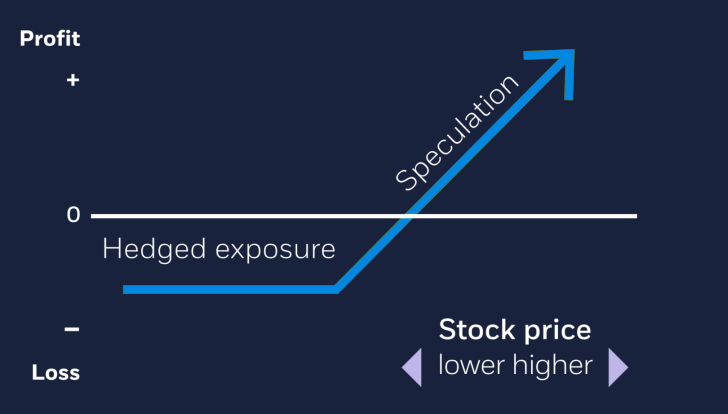How to buy call options
E*TRADE from Morgan Stanley
Options are powerful tools that can be used by investors in different ways, and there is a relatively simple options strategy that can benefit buy-and-hold stock investors. This strategy allows them to maintain their opinion that a stock’s price is going higher—and profit from an anticipated increase—but limits their risk to the downside in the event they’re wrong.
This options strategy is referred to as the stock replacement call.
How it works
By purchasing a call instead of shares, you are taking advantage of leverage; allowing you to use less money to gain positive exposure to the stock’s price rather than using more money to purchase the stock directly.
Let’s take a look at the possible outcomes from this strategy. If the stock price declines, you lose the premium you paid for buying the call. However, this is a hedged strategy, so your losses are limited to only what you paid for the call versus the potentially larger losses equaling the total decline in the stock had you just bought the stock outright.
If the stock price remains even, you lose some (or all) of the premium you paid for the call. Then you can decide to sell the call for a loss, or exercise your right to buy the stock.
However, if the stock price goes higher, you profit from the increase. Then you have to decide whether you want to exercise your right to buy the stock at the lower price or just sell the call and collect your profit.
Example trade
Let’s assume stock XYZ is currently trading for $145 per share. You would like to buy 200 shares of stock XYZ. You could buy 200 shares for $145/share and have $29,000 of risk in the market. Or, you could buy 2 XYZ 135 calls for $12.50 and have a position very similar economically to owning the stock itself but do so with only $2,500 (2 X $12.50 X 100 = $2,500).
Using a standard profit-and-loss graph, you can see how stock replacement calls allow you to speculate that the price of a stock is going to rise, but also allow you to hedge if the price of the stock were to decline.

One question many traders may ask is, “How does someone choose what strike price to buy?” To help traders decide, there is a mathematical tool available to you called delta.
What is delta?
There are three definitions of delta, which are all true.
- It is the expected change in the value of an option’s price for a $1 move higher in the stock price
- It is the approximate probability that at expiration the stock’s price will be higher than the option’s strike price
- It is the price risk percentage of stock ownership that is currently represented in the option.
These definitions however are only as good as the models upon which they are based and outcomes are subject to changes in market conditions and volatility.
The third definition, in particular, is oftentimes a useful indicator to help determine which calls to buy. You can use the option’s delta to determine what percentage of price risk you want to take versus buying the stock outright. If you buy a 70 delta call, you have 70% of the price risk versus owning the stock outright. If you want a greater amount of price risk you can use a higher delta call; if you want less risk you can use a lower delta call.
Too often new option traders buy out-of-the-money options because they cost less, they think they’re getting a better deal, and they can buy more calls at a cheaper price. However, while the premium may be relatively inexpensive, remember that their probability of expiring in-the-money is very low (according to the second definition of delta above), which also means that the probability for a successful trade is also low.
Once you have decided which calls to buy, and have purchased them, you do need to monitor your position. It is important to note that you do not need to wait until expiration to see what happens; you can always unwind, or close, your options position before expiration. Just because there’s an expiration date attached to the options trade, it does not mean you have to hold it until that date. If the trade is profitable and you want to take your profits earlier than expiration, then do so! Conversely, if you experience losses on the trade and you want to limit further losses, you can just close the trade.
The stock replacement call is a way to maintain positive exposure to an increase in a stock’s price while limiting your risk in the markets, and utilizing less cash to do so. Open an account to start trading options or upgrade your account to take advantage of more advanced options trading strategies.